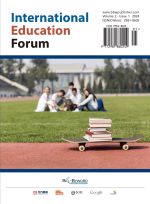Abstract
This study was conducted on 115 students from four classes of 2nd-year intensive courses at B University of Education. Preservice elementary teachers were surveyed on what teaching methods they were aware of regarding the subject of elementary science astronomy. Recognition data of 80 people from whom the questionnaire was collected were analyzed. For this study, a 5-day survey was conducted. Preservice elementary teachers complained of difficulties in teaching methods in the astronomy area of the science department. The purpose of this study was to find out what difficulties preservice elementary teachers have in teaching elementary science astronomy topics and to explore more efficient teaching methods for teaching astronomy topics. The topic of the survey was set by discussing with the preservice elementary teachers about what kind of survey to use in teaching the subject of elementary science astronomy. There are many topics for elementary science astronomy, but two questionnaires were prepared focusing on the unit on the Earth and the moon: “What does the Earth look like?” in Unit 4 (1/10) of the 3rd year, 1st semester; in Unit 2 (1/11) of the 1st semester of the 6th grade, it was set as “What does the moon look like?” The surveys candidly described how to teach the subject of astronomy to elementary school students by mobilizing all the background knowledge of preservice elementary teachers. The results of these surveys were visualized and displayed using NetMiner as a language analysis method, and the contents of the responses to the actual surveys by preservice elementary teachers were described and interpreted. Based on these results, preservice elementary teachers tried to suggest a more efficient teaching method for the subject of elementary science astronomy. In addition, basic procedures and methods for lecturing on the subject of elementary science astronomy were presented. A more efficient teaching method for teaching elementary science astronomy subjects to preservice elementary teachers was suggested.
References
Kim SS, Lee YS, 2017, Effects of an Exploratory Science Writing Class on “Seasonal Changes” on Elementary School Students’ Science Learning Motivation and Scientific Attitudes. Korean Journal of Earth Science Education, 10(3): 278–289.
Lee YS, 2020, Effects of Jigsaw Cooperative Learning on Elementary School Students’ Task Persistence and Creative Personality on “Changes of Seasons” Unit. Korean Journal of Earth Science Education, 13(2): 186–195.
Lee YS, Kim YK, 2016, Effects of “Earth and Moon Movement” Unit Lesson Using Small Group Inquiry Technique on Science Academic Achievement and Scientific Attitude. Korean Journal of Earth Science Education, 9(1): 88–96.
Kim YK, Lee YS, 2016, Effects of “Solar System and Stars” Unit Lesson Utilizing Storytelling on Science Concepts and Science Learning Motivation. Korean Journal of Earth Science Education, 9(1): 97–105.
Aktas I, 2022, The Proficiency and Opinions of the Pre-Service Primary Teachers in Performing Hands-On Science Experiments. Participatory Educational Research, 9(5): 262–287.
Alnasib BNM, 2023, Digital Competencies: Are Pre-Service Teachers Qualified for Digital Education? International Journal of Education in Mathematics, 11(1): 96–114.
Wang HH, Wilson K, VanRooy W, et al., 2023, Pre-Service Primary Teachers’ Competencies in Asking and Conducting Researchable Science Questions Using Fair Testing. Research in Science Education, 53(1): 155–171.
Kim HR, Lee YS, 2021, An Analysis of Elementary Preservice Teachers’ Learning Factors of “Curriculum Reorganization” in Connection with “Weather and Our Life.” Korean Journal of Earth Science Education, 14(2): 202–211.
Lee YS, 2017, Effects of Applying Storytelling Techniques on Elementary Preservice Teachers’ Science Concept Acquisition and Science Teacher Efficacy. Korean Journal of Earth Science Education, 10(2): 226–234.
Lee YS, 2021, A Study of Factors Affecting Elementary Pre-Service Teachers’ Learning Engagement in Online Science Classes. Korean Journal of Earth Science Education, 14(2): 193–201.
Lee YS, Kim SS, 2016, Effects of Cooperative Science Class on Science Teacher Efficacy and Science Knowledge of Elementary Preservice Teachers. Korean Journal of Earth Science Education, 9(3): 341–351.
Lee JA, Lee KY, 2017, A Case Study to Explore Elementary Teachers’ Topic-Specific PCK Development on Earth’s Rotation. Elementary Science Education, 36(4): 405–427.
Park JH, Hyun DG, Shin AK, 2016, The Effect of Lunar Phase Change Observation Teaching Method Considering the Orbits of the Earth and the Moon. Journal of the Korean Earth Science Education Association, 9(3): 323–340.
Shin HJ, Kwon WJ, Ga SH, 2022, A Comparative Analysis of Recent Astronomy Research Keywords and Curriculum Content Elements in the Field of Astronomy. Korean Journal of Education, 42(2): 289–309.
Hwang ER, Son JJ, 2016, Development and Application of an Upside-Down Classroom Program for the “Earth and Moon” Unit in Elementary School. Field Science Education, 10(3): 319–332.
Lim CH, Chae DH, 2018, Content Analysis of the 2009 Revised Science Textbook and the 2015 Revised Science Textbook for Elementary Schools Related to the Topic of “Earth and Moon.” Journal of the Korean Society for Earth Science Education, 11(3): 237–243.
Cho H, Son JJ, 2022, Exploring Ways to Activate Data-Driven Inquiry Activities Using Coding in High School Astronomy Classes. Field Science Education, 16(5): 602–618.
Chae DH, 2022, A Study on the Application of the Sun-Earth-Moon Model to the 6th Grade “Earth and Moon Movement” Unit. Elementary Education Research, 33(2): 299–317.
Han S, Jeong JW, Jeong SK, 2015, Development and Application of a Smart Teaching and Learning Program for the 5th Grade “Earth and Moon” Unit. Korean Journal of Earth Science Education, 8(1): 76–86.
Kim JW, 2022, Pre-service Teachers’ Perceived Problems and Suggestions for Improvement of Textbook Illustrations and Inquiry Activities in Astronomy from the Perspective of Spatial Thinking. Elementary Education, 41(3): 501–520.
Hanson JR, Hardman S, Luke S, et al., 2022, Developing Pre-Service Primary Teachers’ Understanding of Engineering Through Engineering Habits of Mind and Engagement with Engineers. International Journal of Technology and Design Education, 32(3): 1469–1494.
Subramaniam K, Harrell PE, Long CS, et al., 2022, Pre-Service Elementary Teachers’ Conceptual Understanding of Average Speed: The Systematic and Persistence of Related and Unrelated Concepts. Research in Science & Technological Education, 40(2): 189–206.
